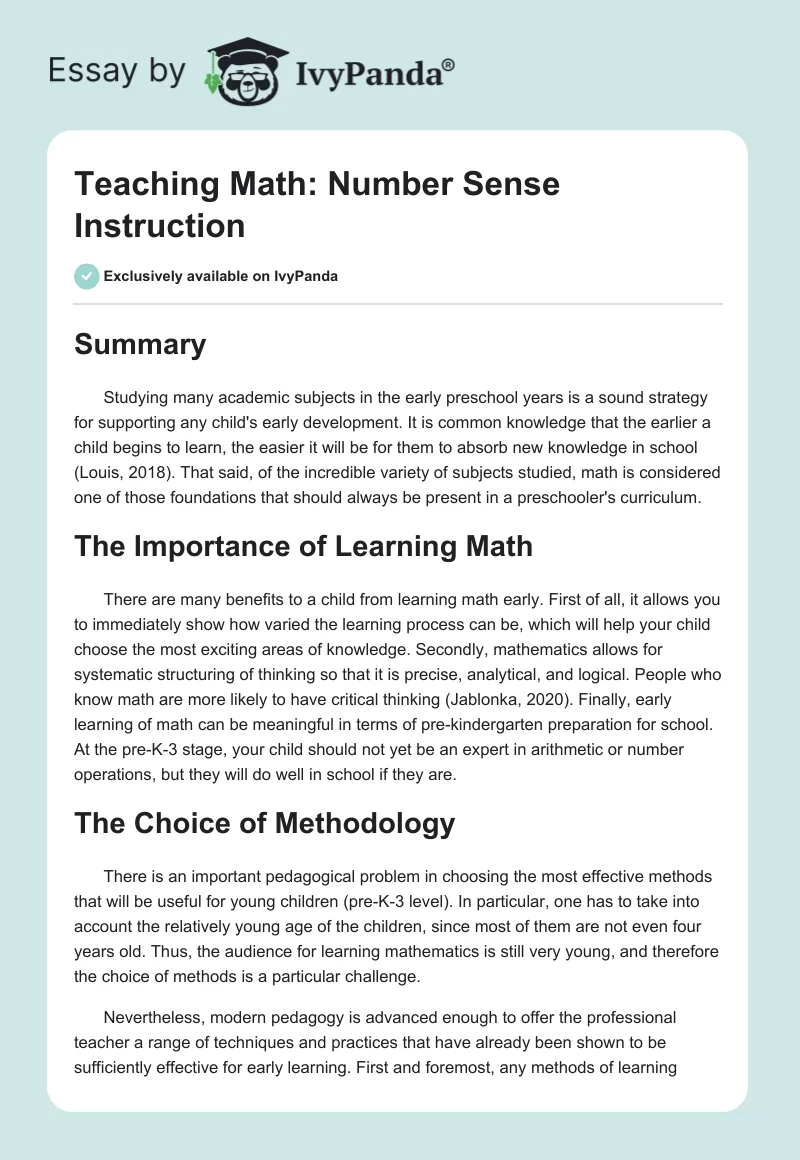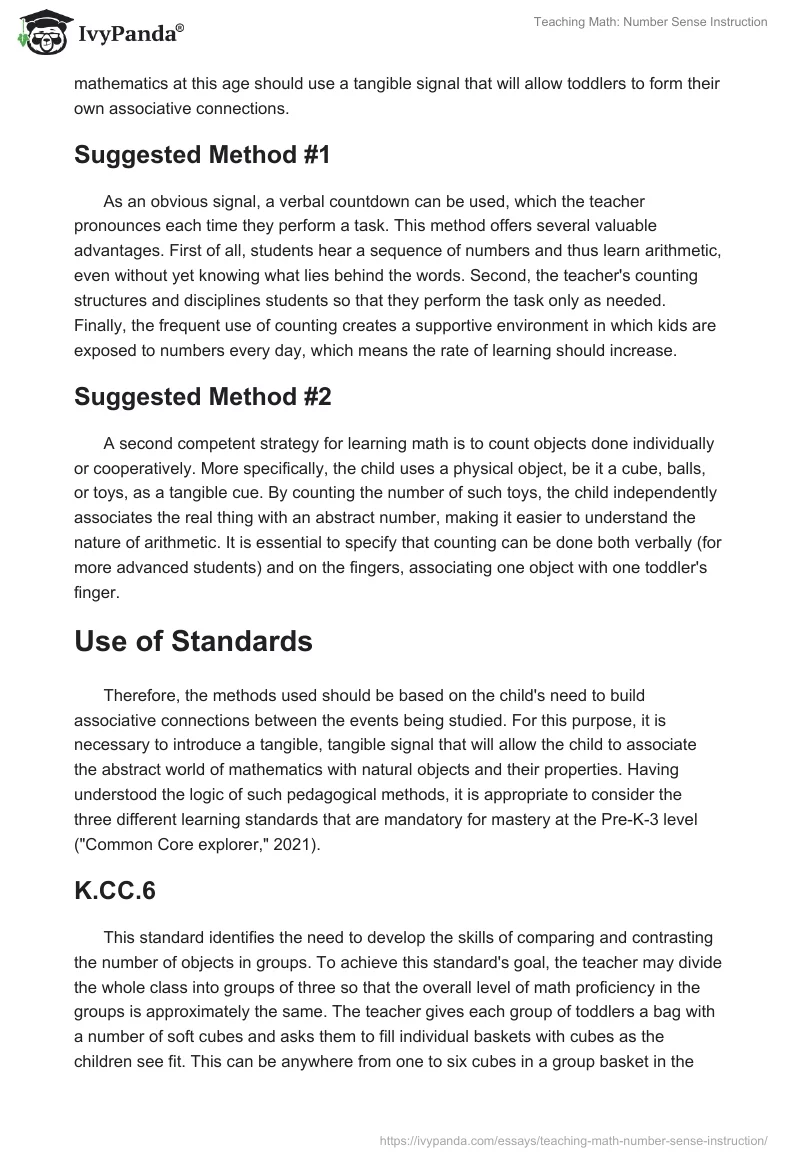Summary
Studying many academic subjects in the early preschool years is a sound strategy for supporting any child’s early development. It is common knowledge that the earlier a child begins to learn, the easier it will be for them to absorb new knowledge in school (Louis, 2018). That said, of the incredible variety of subjects studied, math is considered one of those foundations that should always be present in a preschooler’s curriculum.
The Importance of Learning Math
There are many benefits to a child from learning math early. First of all, it allows you to immediately show how varied the learning process can be, which will help your child choose the most exciting areas of knowledge. Secondly, mathematics allows for systematic structuring of thinking so that it is precise, analytical, and logical. People who know math are more likely to have critical thinking (Jablonka, 2020). Finally, early learning of math can be meaningful in terms of pre-kindergarten preparation for school. At the pre-K-3 stage, your child should not yet be an expert in arithmetic or number operations, but they will do well in school if they are.
The Choice of Methodology
There is an important pedagogical problem in choosing the most effective methods that will be useful for young children (pre-K-3 level). In particular, one has to take into account the relatively young age of the children, since most of them are not even four years old. Thus, the audience for learning mathematics is still very young, and therefore the choice of methods is a particular challenge.
Nevertheless, modern pedagogy is advanced enough to offer the professional teacher a range of techniques and practices that have already been shown to be sufficiently effective for early learning. First and foremost, any methods of learning mathematics at this age should use a tangible signal that will allow toddlers to form their own associative connections.
Suggested Method #1
As an obvious signal, a verbal countdown can be used, which the teacher pronounces each time they perform a task. This method offers several valuable advantages. First of all, students hear a sequence of numbers and thus learn arithmetic, even without yet knowing what lies behind the words. Second, the teacher’s counting structures and disciplines students so that they perform the task only as needed. Finally, the frequent use of counting creates a supportive environment in which kids are exposed to numbers every day, which means the rate of learning should increase.
Suggested Method #2
A second competent strategy for learning math is to count objects done individually or cooperatively. More specifically, the child uses a physical object, be it a cube, balls, or toys, as a tangible cue. By counting the number of such toys, the child independently associates the real thing with an abstract number, making it easier to understand the nature of arithmetic. It is essential to specify that counting can be done both verbally (for more advanced students) and on the fingers, associating one object with one toddler’s finger.
Use of Standards
Therefore, the methods used should be based on the child’s need to build associative connections between the events being studied. For this purpose, it is necessary to introduce a tangible, tangible signal that will allow the child to associate the abstract world of mathematics with natural objects and their properties. Having understood the logic of such pedagogical methods, it is appropriate to consider the three different learning standards that are mandatory for mastery at the Pre-K-3 level (“Common Core explorer,” 2021).
K.CC.6
This standard identifies the need to develop the skills of comparing and contrasting the number of objects in groups. To achieve this standard’s goal, the teacher may divide the whole class into groups of three so that the overall level of math proficiency in the groups is approximately the same. The teacher gives each group of toddlers a bag with a number of soft cubes and asks them to fill individual baskets with cubes as the children see fit. This can be anywhere from one to six cubes in a group basket in the end. Two groups of toddlers are then chosen to guess how many cubes are hidden in the other group’s basket. Once both numbers are called out, each of the two groups takes turns pulling the cubes to the floor, and the number is counted. The team of children that ends up guessing the most tries is the winner of the game.
K.CC.2
This standard specifies the need to count numbers in a given sequence but not necessarily starting with one. For young children, a game with large cards on which numbers from 1 to 12 are written can be offered. It is an individual task, and the child is asked to sort the cards independently in order of the number shown on them. Children are expected to have difficulty completing the task, and this is normal. To make it easier for those students who will need it, the teacher can offer alternative cards that show apples in the same number next to the number. Thus, the more accessible version of the assignment involves the same sorting of the cards, only with additional help in the form of working with apples, not just numbers.
K.MD.1
This standard aims to teach children early skills in using technical and instrumental methods to measure the properties of objects. Properties are weights, lengths, or widths: i.e., those that can be measured with a ruler or with scales. To implement this skill, the teacher asks the students to perform an individual task, the essence of choosing absolutely any object in the classroom and measuring it. For example, the student can take a cube, a textbook, a pencil, or any soft toy. It is the child’s task to consistently measure the weight of the chosen object (using technical scales) and such parameters as length, width, and height (if relevant). This strategy has several practical advantages. In particular, the child gets to know that not all shapes are convenient to measure, for example, it is difficult to measure the length or width of a ball. In addition, this activity will develop skills of independent work, working with equipment and analysis. Finally, each student will feel personally responsible for the outcome, which means there will be increased engagement. The use of technology allows teachers to create a culture that fits today’s agenda, which means such lessons are relevant. In addition, it has been shown that students are more likely to engage in lessons if they use technology they are familiar with: smartphones, tablets, or computers. As part of the mathematics lessons described, it is appropriate to develop a technology implementation strategy that achieves the intended goals. In particular, for the last lesson, measurements, the teacher might suggest that students create a common photo collection collecting each student’s results. To do this, when the kid finishes the measurements, he takes a picture of his object and gives the results to the teacher to create a common poster with the objects, their corresponding measurements, and the student’s name. Such a poster can hang in the classroom and remind students of the skills they have learned.
References
Common core explorer. (n.d.). Common Sense Education. 2021, Web.
Jablonka, E. (2020). Critical thinking in mathematics education [PDF document]. Web.
Louis, A. (2018). The importance of math in the early years. ECEB. Web.
Zaheer, S., Butt, S. M., Anatolyevna, G. V., & Salmani, H. (2018). Do mobile technology in the classroom really improve learning outcomes? International Journal of Evaluation and Research in Education, 7(3), 188-193.


